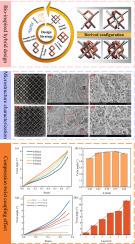具有功能集成的三维压扭耦合手性晶格仿生混合设计及力学性能研究
IF 7.1
2区 材料科学
Q1 MATERIALS SCIENCE, COMPOSITES
引用次数: 0
摘要
目前的晶格结构缺乏扭转特性,在大变形下的研究还不够充分,限制了它们在先进工程中的潜力,特别是模态转换。受DNA的手性双螺旋结构的启发,我们提出了一种将空间螺旋手性与体心立方(BCC)拓扑相结合的构型,创造了一类新的三维手性晶格。本研究以四螺旋手性杂化(FHC-BCC)单元胞为研究对象,通过准静态压缩实验和有限元模拟研究了其大变形力学响应。采用选择性激光熔化(SLM)法制备试样,在万能试验机上进行测试。参数分析表明,混合构型在变形过程中保持了稳定的扭转,增强了能量吸收,并保持了平行韧带的取向。增加支撑直径d可以提高相对密度,改善能量耗散,实现捻度演变的线性调制,而增加层数N可以增加致密化应变并细化压扭耦合,从而实现可编程捻度控制。这些结果突出了几何拓扑协同作用在调节机械性能方面的作用,并拓宽了多功能超材料的设计空间。所提出的架构为具有可调模式转换能力的高性能、功能集成晶格系统提供了一条可行的途径。本文章由计算机程序翻译,如有差异,请以英文原文为准。

Bio-inspired hybrid design and mechanical properties of 3D compression-twist coupling chiral lattice with functional integration
Current lattice structures lack twist characteristics and remain insufficiently studied under large deformations, limiting their potential in advanced engineering, particularly mode conversion. Inspired by the chiral double-helix of DNA, we propose a configuration integrating spatial helical chirality with body-centered cubic (BCC) topology, creating a new class of three-dimensional chiral lattices. This study focuses on the four-helix-chiral hybrid (FHC-BCC) unit cell, examining its large-deformation mechanical response via quasi-static compression experiments and finite element simulations. Specimens were fabricated using selective laser melting (SLM) and tested on a universal testing machine. Parametric analysis shows the hybrid configuration sustains stable twisting, enhances energy absorption, and maintains parallel ligament orientation during deformation. Increasing strut diameter d raises relative density, improves energy dissipation, and enables linear modulation of twist evolution, while increasing layer number N augments densification strain and refines compression-twist coupling for programmable twist control. These results highlight the role of geometric-topological synergy in tuning mechanical performance and broaden the design space for multifunctional metamaterials. The proposed architecture provides a viable route to high-performance, functionally integrated lattice systems with tunable mode conversion capability.
求助全文
通过发布文献求助,成功后即可免费获取论文全文。
去求助
来源期刊

Composite Structures
工程技术-材料科学:复合
CiteScore
12.00
自引率
12.70%
发文量
1246
审稿时长
78 days
期刊介绍:
The past few decades have seen outstanding advances in the use of composite materials in structural applications. There can be little doubt that, within engineering circles, composites have revolutionised traditional design concepts and made possible an unparalleled range of new and exciting possibilities as viable materials for construction. Composite Structures, an International Journal, disseminates knowledge between users, manufacturers, designers and researchers involved in structures or structural components manufactured using composite materials.
The journal publishes papers which contribute to knowledge in the use of composite materials in engineering structures. Papers deal with design, research and development studies, experimental investigations, theoretical analysis and fabrication techniques relevant to the application of composites in load-bearing components for assemblies, ranging from individual components such as plates and shells to complete composite structures.
 求助内容:
求助内容: 应助结果提醒方式:
应助结果提醒方式:


